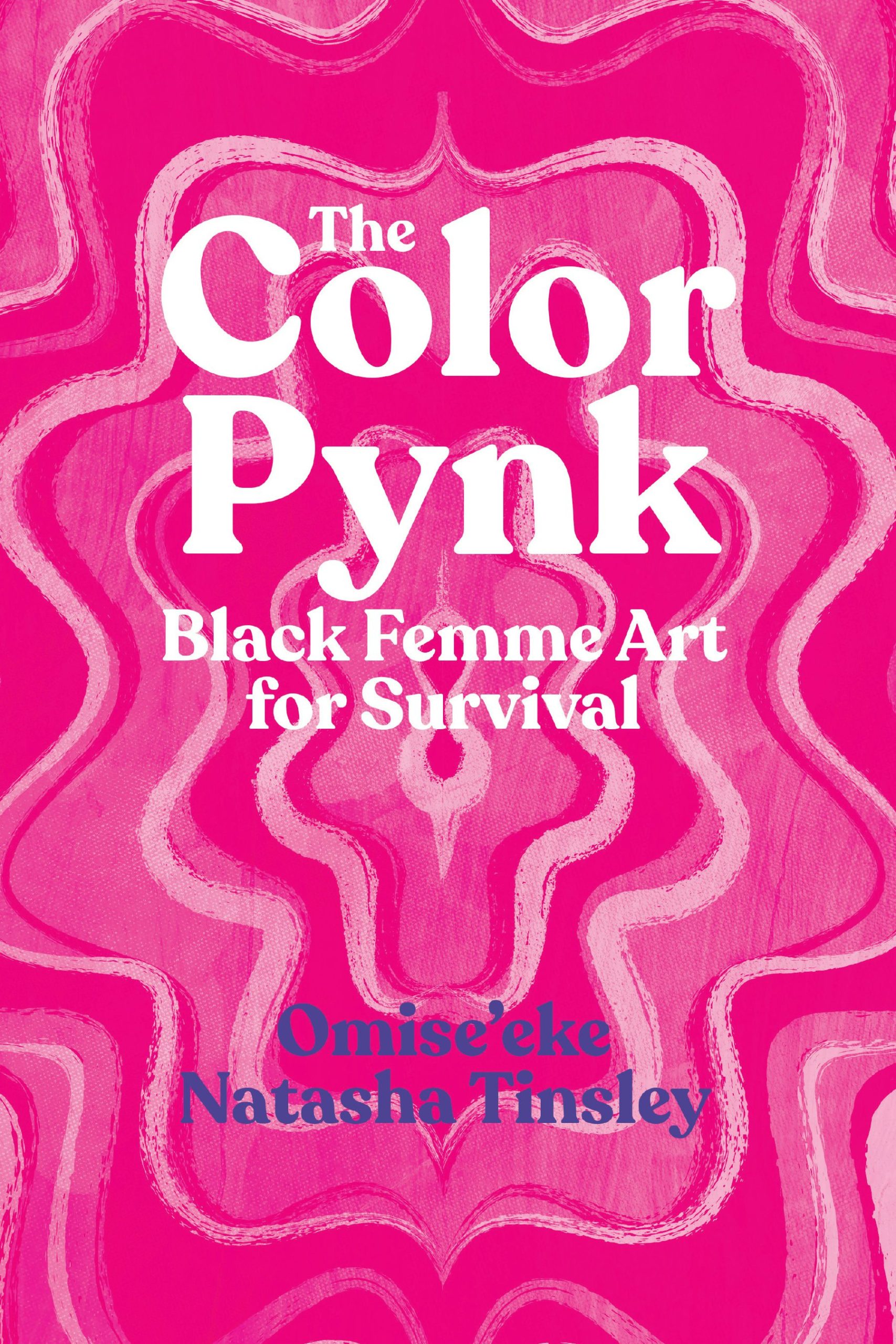
Review by Cinnamon Williams, University of Florida
Publisher: University of Texas Press, 2022
Length: 280 pages
Thinking with and through color is a lineage of Black women’s writing. In 1970, Toni Morrison pondered the meaning of beauty through a dark-skinned, little Black girl’s desire for blue eyes. Famously, in 1983, Alice Walker imagined a deeper and more communal practice for women’s liberation, marking womanist as the purple to feminist’s lavender. In 1999, Joan Morgan longed for a feminism that could fuck with the grays. Writing across a spectrum—black, white, and in color—Hortense Spillers mapped questions of the intramural in Black Studies in 2003. In 2016, Chelsea Frazier brought Black and green together, spotlighting Black feminist narrative and visual disruptions of white ecological frameworks. And in 2018, Amber Jamilla Musser offered a fleshier theory of racialization through interrogating the relational, sensational exchanges between Blackness and brownness. Consider Omise’eke Natasha Tinsley’s 2022 The Color Pynk: Black Femme Art for Survival a rosy and femme-forward addition to this rainbow. Through this work, Tinsley offers “a loving, lingering note on Black femmes’ poetics of survival in the Trump era and beyond” (7). By taking in shades of pink, she contends, we can think expansively about the everyday modes of resistance that Black, queer femmes offer the world in times of crisis and catastrophe: those as seemingly silly as lipstick or pussy pants and those as stirring as environmental justice or vegan feminism.
Tinsley ambitiously brings dynamic modes of resistance together in this text that lets Black, queer femmes speak to each other across artistic medium, platform, and gender presentation. It is anchored by Janelle Monáe and Kelsey Lu’s music, Indya Moore and (F)empower’s fashions, and the films/videos of Tourmaline and Juliana Huxtable. But Tinsley’s theoretical base is even larger if you consider the ballet slipper pink blocks of text that interrupt and enrich the more sustained treatments: Celie’s practice of making folkspants; Miss Major’s commentary on the place of her dick in her conception of womanhood; lesbian couple/owners of BLK MKT Vintage Kiyanna Stewart and Jannah Handy’s theorizing of Black vintage; and Raquel Willis’ musings on walking through a cotton field and feeling the rough edges of bolls, among them. Tinsley stitches these varied modes of thinking together through a framework of Black femme-inism, a kind of thought that “distinguishes itself from Black feminism by its queerness, and from white femme-inism by its Blackness” (10). Her central argument is that Black femme-inism produces race-specific, gender-specific, and desire-specific aesthetics and discourses of freedom. These Black, femme, and queer ways of thinking interrupt established understandings of race, gender, and sexuality, precipitating an endless list of possibilities for moving away from, around, between, and against the boundaries laid out for us. In conceptualizing Black femme-inist thought so widely, Tinsley illuminates the many campaigns Black, queer femmes have mounted against a four-year regime of terror: in music, on film, in water, through food.
The Color Pynk is divided into three parts. Part one, “Pussy Power and Nonbinary Vaginas,” stages a conversation between Janelle Monáe’s pynk vagina pants and Indya Moore’s nonbinary wild vagina dresses. Here, Tinsley foregrounds a theory of relationality between Black, queer cis, trans, and non-binary femmes, finding synergy between these two artists’ reworking of what vaginas and penises can represent for Black femmes. Part two, “Hymns for Crazy Black Femmes,” uses Kelsey Lu’s music and Tourmaline’s films as instruments for thinking femme and disability together. With these chapters, Tinsley showcases how Black femmes use intricate braid styles and ornate head scarves to claim psychiatric disability as a resource, and not a liability, for Black femme being. Finally, part three, “Black Femme Environmentalism for the Futa,” takes up (F)empower’s sustainably produced, environmentally friendly swimwear and Juliana Huxtable’s transspecies posters and performances to destabilize white imaginings of environmental freedom. In these concluding chapters, Tinsley elevates understandings of environmental justice that dislodge individuality to center collectivity and bind Black femmes’ well-being to the Earth’s health.
One of the most captivating elements of Tinsley’s work is her brief attention to the material labors of Black, queer femme living—not just in terms of performing gender (doing makeup, styling hair, thrifting for and assembling outfits) but also of literally working towards a new world. Much of Tinsley’s text frames Black femmes’ political interventions in a celebratory way, and rightfully so. There is much to valorize about those subjects whose everyday sartorial style is deemed unserious; participation in political protest rendered simultaneously indispensable and invisible; and rigorous theorizing of gender and sexuality reduced to frivolity or excess. But she gestures away from this celebratory tenor in part two, lingering in the actual impact of daily survival on Black, queer femmes. Do Black, queer femmes get to be exhausted? Disillusioned? Do they get to have dreams of no longer surviving? Tinsley touches these questions most deeply through a discussion of Los Angeles-based Black femme singer Kelsey Lu’s music (and also later in part three’s analysis of Juliana Huxtable laughing at the absurdity of traditional forms of protest in these times) and answers a resounding yes to all of them. To pose them, Tinsley insists, is to “hear depression out as part of black femme experience” (108). That is, Black femme freedom is figured here as space for the fullness of Black femme emotional and psychic life. By making conceptual space for sadness, depression, exhaustion, and disinterest, Tinsley subtly pushes back against the notion that Black femmes be perpetually strong and always available to care for others.
Tinsley is insistent that the temporal frame of the Black femme offerings under consideration here (2017-2020) speaks to a particular political moment—one that seemed to unsettle white Americans across the political spectrum because of Donald Trump’s more brazen displays of racism, misogyny, and disregard for electoral structures. And yet, a question remains about this framing, partially because of the text’s bookends: an introductory tribute to Alice Walker and the quiet, steady literary protests she launched throughout the Reagan Years, and Tinsley’s concluding call to action for Black femmes “in the Biden era and beyond” (212). It seems that Black femmes are always already producing art for survival. What exactly makes the Trump era distinctive for Black femmes’ artistic production then? What does Black femme protest in seemingly more liberal moments have to offer, such as when Assata’s Daughters halted Chicago traffic during the Obama presidency to call for an end to State Attorney Anita Alvarez’s tenure and an increased budget for predominantly Black serving-Chicago State University? What might Black femme art of the liberal eras before and after Trump tell us, with their analogous policies of deportation to Central America, South America, and the Caribbean; violence against Palestinians; COVID-19 negligence; and erosion of reproductive rights?
Finally, another query lingers about Tinsley’s departure from Black, queer femmes’ fictional and non-fictional literary production in this moment, especially since the text is produced in the vein of Walker’s 1983 In Search of our Mothers’ Gardens: Womanist Prose. I gesture towards these, especially the fictional works, because they also might tell us something important about the worlds that Black, queer femmes have called into being on the page. How might works in those genres add to, or challenge, her interpretations of the moment?
The Color Pynk appears as a beautifully experimental and generous text, where a new concept emerges to help us theorize from the ground that the Black, queer femme has tilled, rather than asking her to fit within a failed feminist framework. Daringly, she challenges readers to revise what they think of as feminist resistance under Trump and what we readily mark as Black or queer in ways that erase Black femmes. With this, Tinsley offers a kind of scholarship that generates as many pathways forward as the Black femme-inist artistic practices at the center of the work.
Cinnamon Williams is Assistant Professor of Gender, Sexuality, and Women's Studies at the University of Florida. Willliams' research interrogates how gender continues to organize and constrain Black domestic life. Her book project charts a Black feminist tradition of marking the domestic as a problem for Black women throughout the 1960s, '70s, and '80s. She holds her PhD in Black Studies from Northwestern University.
